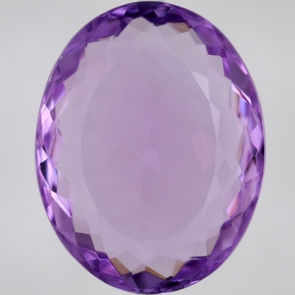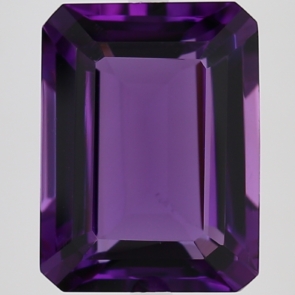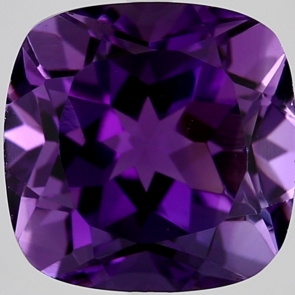
Amethyst (Jamunia) is a violet to purple-colored, semi-precious gemstone from the Quartz mineral family. It is widely respected in Vedic astrology for its calming and protective qualities. Amethyst is worn to bring mental clarity, inner peace, emotional balance, and spiritual growth. It is considered beneficial for those involved in meditation, healing practices, artistic endeavors, and intellectual work.
Amethyst is a beautiful purple variety of quartz that has been cherished for centuries for its stunning color and spiritual significance. Here’s an overview of Amethyst:
Color: Amethyst’s color can range from pale lavender to deep violet, with the most prized specimens exhibiting a rich, saturated hue. The color is due to trace amounts of iron impurities within the quartz crystal lattice.
Clarity: Amethyst is typically transparent to translucent, with good clarity. However, it can contain inclusions or zoning, which are natural features of the stone.
Origin: Amethyst is found in various locations worldwide, including Brazil, Uruguay, Zambia, Russia, and the United States. Some regions are known for producing particularly high-quality Amethyst specimens, such as the Artigas region of Uruguay and the Minas Gerais region of Brazil.
Metaphysical Properties: Amethyst has long been associated with spiritual and metaphysical properties. It’s considered a stone of protection, purification, and spiritual growth. Amethyst is believed to help calm the mind, enhance intuition, and promote emotional balance and clarity. It’s often used in meditation practices and spiritual healing rituals.
Birthstone: Amethyst is the birthstone for the month of February and is associated with the zodiac sign of Pisces. It’s a popular choice for jewelry, especially in rings, earrings, pendants, and bracelets.
Historical Significance: Throughout history, Amethyst has been prized by various cultures and civilizations. Ancient Greeks and Romans believed that Amethyst could prevent intoxication and promote sobriety, leading to the use of amethyst wine goblets. In medieval Europe, Amethyst was considered a symbol of royalty and was often used in religious jewelry and regalia.
Care: Amethyst is relatively durable but can be susceptible to scratching and damage from rough handling. It’s important to store Amethyst jewelry separately from harder gemstones to prevent scratches. Cleaning with mild soap and water is usually safe, but ultrasonic cleaners and harsh chemicals should be avoided.
Overall, Amethyst is a captivating gemstone with a rich history and a wide range of uses, from jewelry to spiritual practices. Whether admired for its beauty or valued for its metaphysical properties, Amethyst continues to captivate and inspire people around the world.
In Vedic astrology, Amethyst, known as ‘Kataila Mani’ or ‘Jamunia,’ is associated with the planet Saturn (Shani). According to Vedic astrology, each planet is believed to govern specific aspects of life, and wearing gemstones associated with these planets is believed to enhance their positive influences while mitigating their negative effects. Here are some purported benefits of wearing Amethyst in Vedic astrology:
Mitigation of Saturn’s Malefic Effects: Saturn is considered a karmic planet that represents discipline, responsibility, and lessons learned through hardship. However, Saturn’s influence can also manifest as delays, obstacles, and challenges. Wearing Amethyst is believed to help mitigate Saturn’s malefic effects and bring balance and harmony into one’s life.
Promotion of Spiritual Growth: Saturn is also associated with spiritual growth, self-discipline, and inner wisdom. Amethyst’s connection to Saturn is believed to enhance these qualities, promoting spiritual awareness, meditation, and introspection.
Alleviation of Anxiety and Stress: Saturn’s influence can sometimes manifest as anxiety, depression, or feelings of restriction. Amethyst is believed to have a calming and soothing energy that helps alleviate stress and promote emotional balance and tranquility, thus reducing the negative effects of Saturn’s influence.
Enhancement of Concentration and Focus: Saturn governs discipline and concentration, and wearing Amethyst is believed to enhance mental focus, clarity, and concentration. This can be beneficial for students, professionals, and anyone seeking to improve their cognitive abilities and productivity.
Protection from Negative Energy: Saturn is associated with karma and life lessons, and its influence can sometimes attract negative energy or challenges. Amethyst is believed to create a protective shield around the wearer, warding off negative influences and promoting a sense of spiritual protection and well-being.
Support for Spiritual Practices: Saturn’s influence can encourage discipline and dedication to spiritual practices, and wearing Amethyst is believed to enhance one’s commitment to meditation, prayer, and other spiritual disciplines.
It’s important to note that while these beliefs are based on traditional Vedic astrology, there is no scientific evidence to support the metaphysical properties of gemstones. Individuals interested in using Amethyst or any other gemstone for astrological purposes should consult with a qualified astrologer or gemstone expert for guidance tailored to their specific birth chart and circumstances.
Amethyst is believed to offer various metaphysical and healing benefits, although it’s important to note that these claims are not scientifically proven. Here are some of the purported benefits of Amethyst:
Spiritual Growth and Intuition: Amethyst is often associated with spiritual growth, enlightenment, and enhanced intuition. It’s believed to facilitate connection with higher realms of consciousness, promoting spiritual awareness and insight.
Emotional Balance and Stress Relief: Amethyst is said to have a calming and soothing energy that helps alleviate stress, anxiety, and emotional turmoil. It’s believed to promote inner peace, balance emotions, and encourage a sense of tranquility and relaxation.
Clarity of Mind and Mental Focus: Amethyst is thought to clear the mind of negative thoughts and mental clutter, promoting mental clarity, concentration, and focus. It’s often used as a tool for enhancing cognitive function and problem-solving abilities.
Protection and Purification: Amethyst is considered a protective stone that wards off negative energy and psychic attacks. It’s believed to create a shield of spiritual protection around the wearer, purifying the aura and creating a sense of safety and security.
Physical Healing: While not scientifically proven, Amethyst is sometimes used in alternative healing practices to aid in the treatment of various physical ailments. It’s said to support the immune system, alleviate pain, and promote overall health and well-being.
Sleep Aid and Dream Enhancement: Amethyst is believed to have a calming influence that helps promote restful sleep and lucid dreaming. Placing an Amethyst crystal under the pillow or near the bed is thought to facilitate deep relaxation and enhance dream recall.
Chakra Balancing: In spiritual practices, Amethyst is often associated with the crown chakra, which governs spirituality, consciousness, and enlightenment. It’s believed to cleanse and balance this chakra, promoting spiritual connection and higher states of consciousness.
Addiction Recovery: Due to its historical association with sobriety and moderation, Amethyst is sometimes used as a supportive aid in addiction recovery programs. It’s believed to help break addictive patterns and support individuals in overcoming substance abuse.
It’s important to remember that these purported benefits are based on anecdotal evidence and traditional beliefs rather than scientific research. Individual experiences with Amethyst may vary, and it’s always advisable to consult with a qualified healthcare professional for any medical concerns.
The price of Amethyst can vary widely depending on several factors such as quality, size, color, clarity, and origin. Here’s a general overview of Amethyst prices based on these factors:
Quality: The quality of Amethyst can vary significantly, with higher-quality stones commanding higher prices. Factors such as color saturation, clarity, and transparency influence the overall quality of the gemstone.
Size: Larger Amethyst gemstones generally command higher prices per carat compared to smaller stones, especially if they exhibit good color and clarity.
Color: The most prized Amethyst gemstones exhibit a deep, rich purple color with excellent clarity and transparency. Stones with intense color saturation and uniformity are typically more valuable.
Clarity: Amethyst with minimal inclusions and good transparency is considered more valuable than stones with visible flaws or cloudiness.
Origin: Amethyst from certain locations, such as Uruguay, Zambia, and Brazil, may command higher prices due to their reputation for producing high-quality specimens.
Based on these factors, here are some general price ranges for Amethyst:
- Low-Quality Amethyst: Low-quality Amethyst with pale color, poor clarity, and small size can be relatively inexpensive, starting from Rs 100 per carat.
- Medium-Quality Amethyst: Medium-quality Amethyst with decent color, clarity, and size typically ranges from Rs 200 to Rs 300 per carat.
- High-Quality Amethyst: High-quality Amethyst with intense color, excellent clarity, and larger size can range from Rs 600 to Rs 700 or more per carat.
- Exceptional Amethyst: Exceptional Amethyst specimens with rare color variations, exceptional clarity, and large size can command prices of Rs 1000 or more per carat, depending on their rarity and desirability.
It’s important to note that these price ranges are general estimates and can vary based on market demand, gemstone quality, and individual seller pricing. Additionally, prices may fluctuate over time due to factors such as supply availability and economic conditions. When purchasing Amethyst or any other gemstone, it’s advisable to buy from reputable dealers who can provide certification and assurance of authenticity.
Amethyst is a versatile gemstone, widely used in various types of jewelry. Its vibrant purple color- ranging from light lavender to deep violet- makes it a popular choice for both casual and formal wear. Here are the main types of Amethyst jewelry:
Amethyst Rings
- Solitaire Rings: Feature a single Amethyst stone, often cut in oval, round, or cushion shapes.
- Halo Rings: Amethyst surrounded by a circle of diamonds or other gems for added sparkle.
- Birthstone Rings: Popular as February birthstone rings.
- Statement Rings: Large, uniquely cut Amethysts set in bold, artistic designs.
Amethyst Necklaces & Pendants
- Solitaire Pendants: A single Amethyst on a delicate chain-classic and elegant.
- Cluster Pendants: Multiple Amethysts or mixed gemstones in a single pendant.
- Beaded Necklaces: Amethyst beads strung together for a more bohemian or traditional look.
- Chakra Necklaces: Often used in spiritual jewelry as the stone is associated with the crown chakra.
Amethyst Bracelets
- Tennis Bracelets: A line of small Amethysts (sometimes alternating with diamonds).
- Beaded Bracelets: Natural Amethyst beads often used in healing or meditation jewelry.
- Charm Bracelets: With Amethyst charms for personalized styling.
Amethyst Earrings
- Studs: Simple and elegant, suitable for everyday wear.
- Drop Earrings: Longer, dangling designs that showcase the gem’s beauty.
- Hoop Earrings: Hoops adorned with small Amethyst stones or dangles.
- Chandelier Earrings: Ornate and dramatic, often used in evening wear.
Amethyst Brooches & Pins
- Often vintage or antique styles.
- Can be combined with other colored gemstones in floral or abstract patterns.
Amethyst Jewelry Sets
- Coordinated sets that include a matching necklace, earrings, and bracelet or ring.
- Great for special occasions like weddings, anniversaries, or gifts.
Spiritual & Healing Jewelry
- Meditation Malas: 108-bead Amethyst necklaces used for spiritual practice.
- Crystal Healing Jewelry: Worn to promote calm, clarity, and spiritual awareness.
- Zodiac Jewelry: Especially for Pisces and Aquarius.
Amethyst is a beautiful and relatively durable gemstone, but like all gemstones, it requires proper care to maintain its luster and prevent damage. Here’s how to clean and care for your Amethyst:
Cleaning Amethyst
Gentle Cleaning (Recommended)
- What you’ll need: Mild dish soap, lukewarm water, a soft toothbrush or cloth.
- Steps:
- Fill a bowl with lukewarm water and add a few drops of mild dish soap.
- Soak the Amethyst for 10–15 minutes.
- Use a soft toothbrush to gently scrub the stone, especially around any settings if it’s in jewelry.
- Rinse thoroughly under lukewarm water.
- Dry with a soft, lint-free cloth.
Ultrasonic Cleaner
- Safe for most Amethyst gemstones only if untreated and free from significant inclusions or fractures.
- Avoid if you’re unsure about the stone’s treatment or if it’s mounted in a delicate setting.
What to Avoid
- Steam cleaners-heat can damage or fade Amethyst.
- Harsh chemicals or cleaners with bleach, ammonia, or acids.
- Prolonged soaking, especially for mounted stones, to avoid loosening the setting.
Care Tips for Amethyst
Avoid Heat and Sunlight
- Amethyst can fade if exposed to high heat or prolonged sunlight.
- Store it in a cool, dark place when not in use.
Store Properly
- Store separately in a fabric-lined box or pouch to prevent scratches.
- Amethyst ranks 7 on the Mohs scale, so it can scratch softer stones and be scratched by harder ones like sapphires or diamonds.
Avoid Chemicals
- Remove Amethyst jewelry before using household cleaners, swimming in chlorinated pools, or applying lotions/perfume.
Check Settings
- If your Amethyst is in a ring or pendant, occasionally check the setting to ensure the stone is secure.
- If you’re not sure whether your Amethyst is treated (e.g., heat-treated or dyed), it’s best to stick with gentle cleaning methods and consult a jeweller for more specific care.
Beware of Misrepresentation: One common issue in the gemstone market is misrepresentation, where synthetic or treated stones are sold as natural or untreated. Be wary of sellers who make claims about the quality or origin of the Amethyst without providing proper certification or documentation.
Look for Certification: Reputable gemstone dealers often provide certification or documentation that verifies the authenticity and quality of the stones they sell. Look for certifications from recognized gemological laboratories when purchasing Amethyst.
Examine the Stone: If possible, examine the Amethyst gemstone in person or request detailed photographs that show its color, clarity, and any inclusions. Pay attention to factors such as color consistency, clarity, and transparency to assess the quality of the stone.
Consider the Source: Amethyst can come from various locations worldwide, each with its own characteristics and qualities. Research the origin of the Amethyst and consider factors such as color intensity, clarity, and reputation when making a purchase decision.
Be Wary of Unrealistic Prices: If the price of Amethyst seems too good to be true, it might indicate that the stone is of poor quality, synthetic, or misrepresented. Compare prices from multiple sources and be cautious of sellers offering unusually low prices.
Buy from Reputable Sellers: Purchase Amethyst from reputable dealers or retailers with a track record of selling genuine gemstones. Look for reviews, testimonials, and any affiliations with industry organizations to ensure the seller’s credibility.
Ask Questions: Don’t hesitate to ask the seller questions about the Amethyst, such as its treatment history, origin, and any certifications or guarantees provided. A trustworthy seller should be transparent and willing to provide information to help you make an informed decision.
By staying informed, asking questions, and purchasing from reputable sources, buyers can minimize the risk of encountering issues when buying Amethyst or any other gemstone. It’s important to take the time to research and verify the quality and authenticity of the gemstone to ensure a satisfactory purchase experience.
Featured Products

 Cart is empty
Cart is empty 

